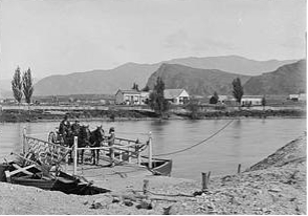The Lower punt
The Lower punt - crossing the clutha river
The period referred to in this plaque is 1877 to 1930, and the names and spellings mentioned are historically correct. Pembroke was the name of the settlement on Lake Wanaka and the name of the township was changed to Wanaka on 1st September 1940. The macron was added to Wanaka in 2021. At that time, the Mata-au branch was the smaller of the two branches of the Clutha between Balclutha to Kaitangata and on to the coast. The word Mata-au was added to Clutha River as part of the settlement with Ngai Tahu on 21st November 1997.
The first ‘ferry’ was a box from an old gig made watertight by caulking and was used as a boat by George Hassing in 1860. By early 1863, he had replaced it with a whaleboat. This crossing was called Albert Crossing after Queen Victoria’s late husband, who died in December 1861. Hassing could see better opportunities operating at Sandy Point about 10 miles (approx. 15.5 Km) downstream. He moved there in March 1863.
Several stores were established. David Robertson started a store and an accommodation house on the north bank (Hāwea side). The business was taken over by Henri Norman in 1863, including the ferry operation. Henri renamed it the Albert Hotel. When Henri was granted a licence for his ferry he converted it to a punt.
In 1863 surveyor John Connel surveyed the settlement on both sides of the river and named it Newcastle. The name was unpopular, and to George Hassing, it only referred to the settlement on the north bank, but only the town on the south bank continued to develop. By the time Robert Kidd established his store on the south bank the name Albert Town was well used.
Henri Norman moved his store and hotel across the river in 1864 and continued to operate it until 1872.
The floods of September 1878 completely erased all trace of ‘Newcastle’ on the north bank of the river. The only reminder that exists is Newcastle Road, starting at Windmill Corner, Hawea Flat, which was the road to the Albert Town punt.
In 1887, the Vincent County Council purchased the Lower Punt. When the Upper Punt, established in 1872, was upgraded to an acceptable standard, it was purchased by the county in 1905.
The county employed James Templeton as puntman, and the puntman’s hut was placed between the two punts on the bank opposite Templeton’s Workshop, where both punts could be seen. James, the first puntman employed by the county, asked for a bicycle to speed up the service of the two punts. It is seen leaning against the hut wall and is possibly the first ‘company’ transport provided by a council in the district.
James Templeton and the puntman’s hut and the early beginnings of Templeton’s workshop.
The punts caused delays for travellers, who had to raise the operator and have the punt transferred to their side of the river. If cars were on the Albert Town side of the river, they could drive to the other punt and pick him up. He often stood on the running board of the car to make the journey. Those on the Hawea side of the river had to ring the bell and wait.
The lower punt continued to operate until November 1930, when the Camphill Bridge was opened.
Bruce Hebband


